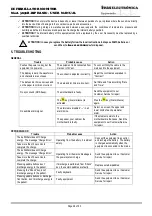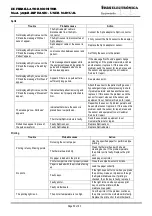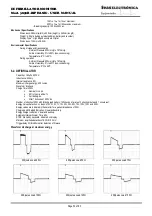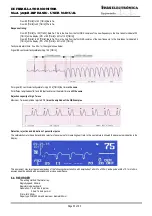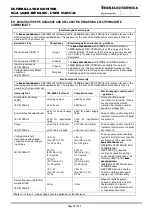
DEFIBRILLATOR MONITOR
Mod. 3850B-BIPHASIC - USER MANUAL
Page 62 of 63
Recommended separation distances between portable and mobile RF communications and the
feas
ELECTRÓNICA
’s DEFIBRILLATOR Monitor Mod. 3850B-Biphasic REC/TPM/SpO
2
The
feas
ELECTRÓNICA
’s DEFIBRILLATOR Monitor Mod. 3850B-Biphasic REC/TPM/SpO
2
is intended for use in an
electromagnetic environment in which radiated RF disturbances are controlled. The customer or the user of the
feas
ELECTRÓNICA
’s DEFIBRILLATOR Monitor Mod. 3850B-Biphasic REC/TPM/SpO
2
can help to prevent
electromagnetic interference by maintaining a minimum distance between portable and mobile RF communications
equipment (transmitters) and the
feas
ELECTRÓNICA
’s DEFIBRILLATOR Monitor Mod. 3850B-Biphasic
REC/TPM/SpO
2
as recommended below, according to the maximum output power of the communications equipment.
Maximum output power
assigned to transmitter
[W]
Separation distance according to transmitter frequency
[m]
150kHz to 80MHz
150kHz to 80MHz
in ISM bands
80MHz to 800MHz
800MHz to
2.5GHz
d
= 1.17 x
√
d
= 1.2 x
√
d
= 1.2 x
√
d
= 2.3 x
√
0.01 0.117
0.12 0.12 0.23
0.1 0.37
0.379 0.379 0.727
1 1.17
1.2 1.2 2.3
10 3.7
3.79 3.79 7.27
100 11.7
12 12 23
For transmitters rated at a maximum output power not listed above, the recommended separation distance
d
in meters (m) can be
determined using the equation applicable to the frequency of the transmitter, where
P
is the maximum output power rating of the
transmitter in watts (W) according to the transmitter manufacturer.
NOTE 1
At 80MHz and 800MHz, the separation distance for the higher frequency range applies.
NOTE 2
The ISM (industrial, scientific and medical) bands between 150kHz and 80MHz are 6.765MHz to 6.795MHz, 13.553MHz to
13.567MHz, 26.957MHz to 27.283MHz and 40.66 MHz to 40.70MHz.
NOTE 3
An additional factor of 10/3 has been incorporated into the formulae used in calculating the recommended separation
distance for transmitters in the ISM frequency bands between 150kHz and 80MHz and in the frequency range 80MHz to 2.5GHz to
decrease the likelihood that mobile/portable communications equipment could cause interference if it is inadvertently brought into
patient areas.
NOTE 4
These guidelines may not apply in all situations. Electromagnetic propagation is affected by absorption and reflection from
structures, objects and people.

